Samsung Portable SSD T3 Review
Samsung Portable SSD T3
A lightning-fast portable SSD with style to match
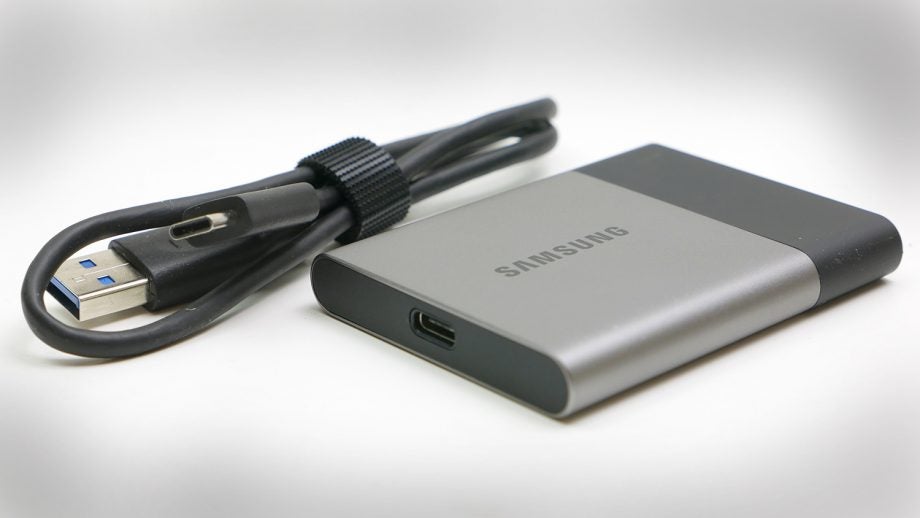
Verdict
Pros
- Stylish design
- Great performance
- Convenience of USB Type-C connection
Cons
- Only USB 3.1 Gen. 1
- More expensive than a normal 2.5in drive
- Not waterproof or ruggedised
Key Specifications
- Review Price: £99.00
- Dimensions: 74 x 58 x 10.5 mm
- Weight: 51g
- AES 256-bit encryption
- Password protection
- USB 3.1 Type-C (Gen.1, 5Gbps)
- 250GB, 500GB, 1TB and 2TB capacities
What is the Samsung Portable SSD T3?
A portable hard disk is all well and good, but their slow speed and vulnerability to drops makes them a liability. Small flash drives are similarly vulnerable, and have the added disadvantage of being incredibly easy to lose. Samsung’s Portable SSD T3 is a middle ground, combining high-speed and decent capacity with a svelte and stylish form factor.
The Samsung Portable SSD T3 is the second generation of Samsung’s ultra-compact but high-performance line of portable SSDs. Following on from the T1 (what happened to the T2? We have no idea) it’s tiny, stylish and comes with a convenient and fast USB 3.1 Type-C connector.
This lot is combined with Samsung’s excellent SSD hardware, which should offer high read and write speeds and long term reliability. Plus there’s built-in hardware encryption for easy password protection of your data.
Samsung Portable SSD T3 – Design and Features
The T3 is an impressively small and lightweight piece of kit. Measuring 74 x 58 x 10.5 mm and weighing just 51g, it’s a good 10mm shorter and narrower than a 2.5-inch SATA SSD, and around 20g lighter. It is 3mm thicker but overall it’s still a far more compact package.
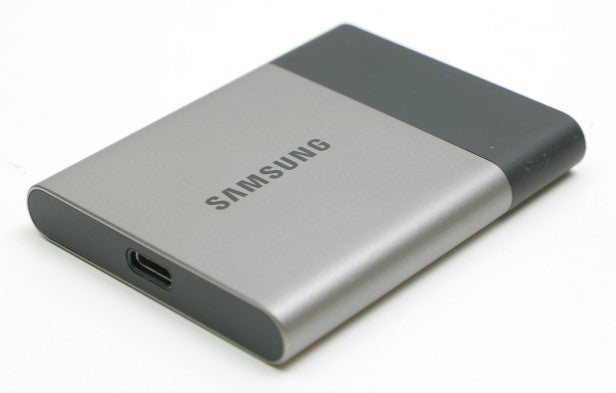
It’s also more stylish. Half finished in aluminium and half in a soft touch matt black plastic, it has a decidedly premium feel, and its rounded sides make it comfortable to hold and mean it won’t likely damaged anything else you’ve thrown into your rucksack.
By the very nature of flash memory, this drive will be pretty resilient to knocks – it should easily survive a drop on the floor – but the casing isn’t specifically ruggedised or waterproof so treating it with care is still highly recommended.
The only feature of note is the USB 3.1 Type-C socket that sits in the middle of one end. While it’s been slow to take off, Type-C certainly is a convenient connection thanks to its reversible plug. This is only a Gen 1 USB 3.1 (essentially USB 3.0 in all but name and form factor in this case) so can only hit 5Gbit/s but that’s still enough for Samsung to claim up to 450MB/s transfer speeds.
To get the most from the drive you’ll obviously want a USB 3.0 or USB 3.1 port but the drive is backwards-compatible with USB 2.0 ports, too. It’ll just be slower.
While it’s still easy enough to just buy a cheap 2.5-inch SSD and a USB 3.0 adapter, Samsung’s offering puts the whole lot together into a more compact and convenient package. Plus, compared to a typical USB flash drive, the SSD-class storage used here is far faster and more robust, allowing Samsung to offer a three-year warranty on these drives.
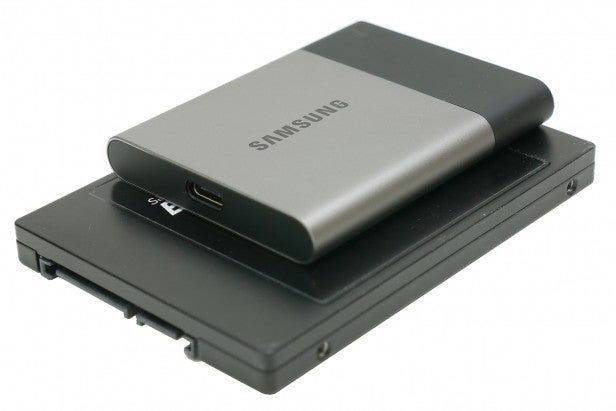
You also get hardware 256-bit AES encryption for secure data storage with no loss of performance. Samsung includes a simple app on the drive that takes care of password management, and there are versions for Windows, Mac and Android.
Inside is a standard Samsung Evo 850 mSATA drive, which Trusted found to be mighty fast in its bare state. It uses Samsung’s unique V-NAND flash that has memory cells stacked vertically as well as horizontally, allowing for incredibly dense memory. This remains a key advantage Samsung has over the competition when it comes to flash memory.
Samsung Portable SSD T3 – Setup and Performance
The drive comes ready to go, with a USB Type-C to Type-A cable in the box. Plug it in and you can use it just like any other USB storage device.
If you’d like to protect your data, though, you’ll have to run Samsung’s software, which is already on the drive and is a simple non-install app that will let you create a password and then protect the drive. Likewise, connect this drive to an Android phone or tablet (the USB on-the-go adapter included with the Samsung Galaxy S7 makes all the more sense now) and download the app and you can access your files on the go. It’s a super-convenient system.
Related: Everything you need to know about USB-C

As for overall performance, starting off with some simple large file transfers (4.37GB), I measured a write speed of 298MB/s and read speed of 364MB/s, which is short of the claimed 450MB/s and some way behind the raw performance of the mSATA drive inside. Nonetheless, they’re still mighty impressive numbers – most hard drives top out at around 100MB/s.
These speeds were also maintained when transferring a large number of smaller files, a task that can sometimes result in slower performance than copying one large file.
What’s more, there was no drop in performance mid-way through writing large files. Some drives use a store of faster memory to allow for fast initial write speeds, with the data then later being put into the slower long term memory. However the Samsung drive’s write speeds were consistent.
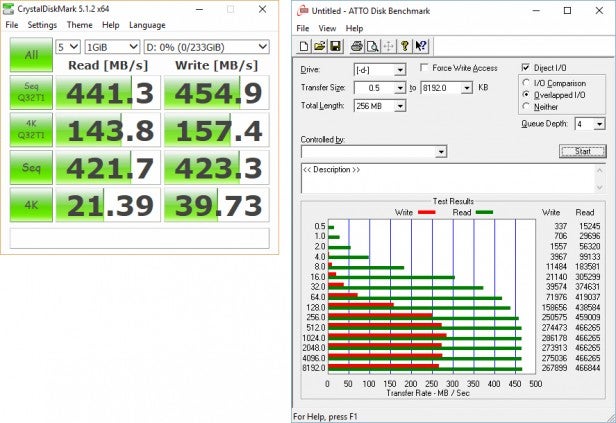
Firing up some synthetic benchmarks, CrystalDiskMark showed that at least under certain conditions the drive can indeed hit 450MB/s for both read and write. Plus there’s evidence of the other key benefit of SSDs, which is their incredibly fast random read and write speeds, a key advantage over hard disks.
Related: Best M.2 SSDs
The Atto Disk benchmark also showed the drive quickly reaches its maximum transfer speed and maintains it for a decent length of time. Here, though, we again see evidence that the real world write speed is closer to 250MB/s than 450MB/s (read speed stays at 450MB/s). It’s possible that the larger capacity drives (I tested the 250GB model) will have slightly faster write speeds, though I can’t say for certain without testing them.
As for enabling encryption, it didn’t cause transfer speeds to drop at all in my tests.
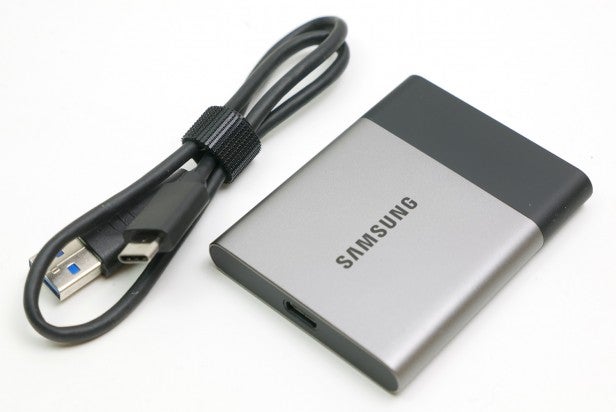
Should I buy the Samsung Portable SSD T3?
The Portable SSD T3 is ideal for those seeking a really compact, convenient, fast and reliable portable storage device. It’s smaller and faster than portable hard disks, more convenient than a 2.5-inch SSD with a USB adapter and faster and more reliable than typical USB flash drives.
For those that just need a lot of portable storage and who don’t need superfast transfer speeds then a portable hard disk will suffice and be cheaper for the same capacity. But if you’re regularly moving large files around, or even working on files directly from your portable drive then the speed of the T3 will be very welcome. With that said, if you need a high-performance external drive for video-related work, a Thunderbolt-based SSD or hard disk will be a much better bet.
You do pay a small premium for the T3 but I think the smart design, convenient package and ready-to-go cross-platform software make up for it. Starting at £99 for the 250GB version, this compares to around £70 for the equivalent 2.5-inch SSD.
Verdict
If you need fast, reliable portable storage then the Samsung Portable SSD T3 is an ideal buy. It is a bit pricier than typical portable hard drives or USB flash drives but you get plenty for the premium.

